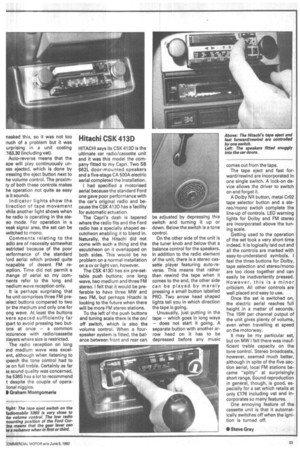Radlomobile 536S
Page 30

Page 31

If you've noticed an error in this article please click here to report it so we can fix it.
THE Radiomobile 5365 is a cor bined auto-reverse stereo ea sette player with a radio coy( ing L, M and FM wavebands. T1 radio section has manual tunii and selectors for six pre-set Si tions.
The cassette deck incorp rates automatic switching fro radio to tape as soon as the ca sette is inserted. Fast forwa and rewind controls are incorp rated as is a programme select which can change the directil of tape play at any time.
The tape side of the Radiorr bile performed well. The soul quality was good, with tonal a justment being availab through a control in the volur switch. This also doubled as balance control when the conti knob was depressed.
I had one reservation: the CE sette drive mechanism produc a noticeable mechanical noi when the car was either park or stationary in traffic. In motic the wind and engine noi
nasked this, so it was not too nuch of a problem but it was ;urprising in a unit costing 1 63.30 (including vat).
Auto-reverse means that the ape will play continuously uness ejected, which is done by gessing the eject button next to he volume control. The proximty of both these controls makes he operation not quite as easy is it sounds.
Indicator lights show the lirection of tape movement vhile another light shows when he radio is operating in the steeo mode. For operation in a veak signal area, the set can be ;witched to mono.
Comments relating to the adio are of necessity somewhat 'estricted because of the poor )erformance of the standard 'ord aerial which proved quite ncapable of decent FM re:eption. Time did not permit a :hange of aerial so my comnents refer to the long and nedium wave reception only. It is perhaps surprising that he unit comprises three FM pre;elect buttons compared to two or the medium and only one for ong wave. At least the buttons rvere spaced sufficiently far tpart to avoid pressing two butons at once — a common )ccurence with radio/cassette )layers where size is restricted. The radio reception on long ind medium wave was excelent, although when listening to .ipeech the tone control had to )13 on full treble. Certainly as far 3s sound quality was concerned, :he 536S has a lot to recommend t despite the couple of opera:ional niggles.
IP Graham Montgomerie


























































